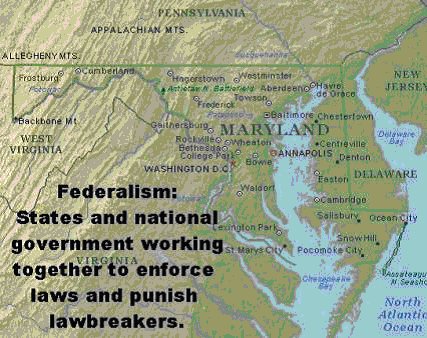
Objectives: The students will...
1. Outline the structure of American government with emphasis on the three levels of government: federal state and local.
2. Describe the U.S. federal system of government and apply it to current events.
3. Identify the powers of federal, state and local governments as outlined in the US Constitution as well as powers that are prohibited to the states and federal government.Materials:
· Graphic Organizer: The Federal System: Got Power?
· Note-taking: The Structure of American Government
· The Structure of American Government
· The Big Box Government Review Sheet
· Overhead projector and transparencies.
· Optional: Computer with Internet access.
Procedures: Students will examine recent events in the news to understand the division of power between the three branches and three levels of American government. They will also examine a diagram that illustrates these concepts.
Description: The warm-up will look at the prosecution of the 2002 sniper shootings as an example of federalism. Students will take notes during a lecture-discussion of the three branches of government.
Post the following question: Title: “Federalism In The News October 23,
2002
"How does the effort to catch the Beltway Sniper represent the federal system of the United States government?"
Have students write the question and their answer in their notes.
Federalism: System where national government shares power with the states.
Develop a diagram or cartoon that describes your answer.
Discuss the answer aloud with students.
The effort to catch the sniper involves two states and the District of Columbia. The following agencies are involved in the search for the Beltway Sniper.
|
· The U.S. military · U.S. Marshals · FBI · ATF (Bureau of Alcohol, Tobacco and Firearms)
|
The states are also working with the federal government to catch the criminals. All levels of government share the power to enforce the law and punish lawbreakers. These powers are concurrent.
A sample diagram might include a map of the states affected and a statement on how these jurisdictions are working together to enforce the law.

Introduce the graphic organizer entitled The Federal System, Got Power? to students by displaying the information on an overhead transparency by writing out the information or by creating a black line transparency with a photocopier. Define the terms in each of the boxes for students and have them enter the information in their notes.
The information file is available as a Word 2000 document or Adobe PDF file.
Distribute the blank note-taking worksheet to students. Have students locate a chart in textbook that indicates what level of government holds that power. You can also use the key overhead as the source for lecture discussion and have students write the information as you present it.
The worksheet is available as a Word 2000 document or Adobe PDF file.
Definitions: Division of Powers of the Federal Government
Delegated/Enumerated: Listed in the Constitution, mostly in Article I, Section 8
Reserved: set aside for the states, usually by Amendment 10.
Concurrent: held by both federal and state levels.
Denied: powers prohibited by Article I, Section 9 and 10 of the Constitution.
Guided Practice: Numbered Heads Together
Here is a game you can play to reinforce any content. In this case, we’ll use it to support students in their understanding of federalism and the three levels of government.
· Have the students form groups of four. Have each student choose to be either number 1, 2, 3, or 4.
· Create a game spinner by taking a blank transparency sheet and punching a thumbtack through the center facing up. Carefully fix a pencil over the exposed thumbtack point. By not pushing down too hard, the pencil should spin with a gentle flick. Use a transparency pen to divide the blank acetate sheet into 4 quadrants, marked with the numbers 1, 2, 3, and 4.
· Ask students orally to identify a power that you name from the “Got Power” worksheet
used earlier in this lesson.
· Have a volunteer from each group spin the spinner while it is displayed on the overhead. Only those students designated with that number may answer the question.
· Students may consult with each other within their groups before the designated student answers. The teacher can choose the group or go in order around the room.
· Instead of playing competitively, you can make it more of a cooperative experience by counting the number of correct answers the class gets in a row. Have the students work together within their teams to break the class record.
· When asking questions from the worksheet, jump around the three levels to keep the students on their toes. Also, use practical examples such as “I always see federal and state taxes taken from my paycheck.” (Answer: Concurrent Power).
Assessment and content reading assignment - The Big Box Review Government Review Sheet
Distribute the worksheet The Big Box Government Review Sheet to students.
Students should use their textbook, Internet and library resources, and previous class notes to complete the worksheet.
Reviewing the Interactive Worksheet
Create a transparency of the teacher version of the worksheet. Display the teacher version of the worksheet on the overhead projector in order to review the information orally with the students.
An online version of the worksheet can be found at http://www.cyberlearning-world.com/lessons/bigbox.htm
that is unique for the state of Virginia. The interactive version can be used to display images and examples by way of computer and/or LCD for each response. To illustrate these concepts graphically, visit a version of the “Big Box” you can display at
http://www.cyberlearning-world.com/lessons/civics/bigbox/bigbox.htm
An answer key for the Virginia Big Box Government Review worksheet is available.
Evaluation: The lesson will be evaluated by…
1. The accuracy of students’ responses on the worksheets related to this lesson;
2. Students’ ability to accurately illustrate the concepts of federalism and the
division of powers.
3. Scores on future tests and quizzes on the federal system.